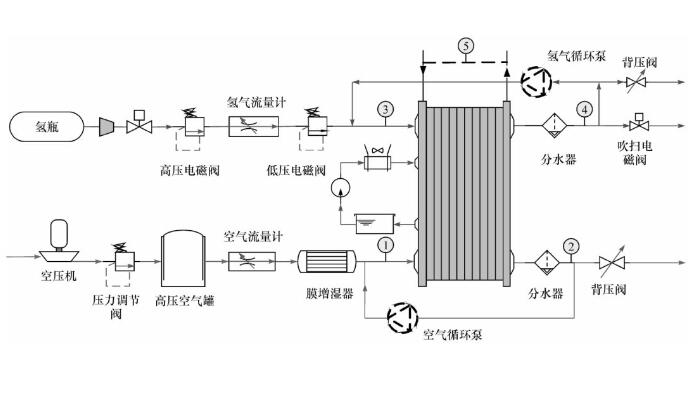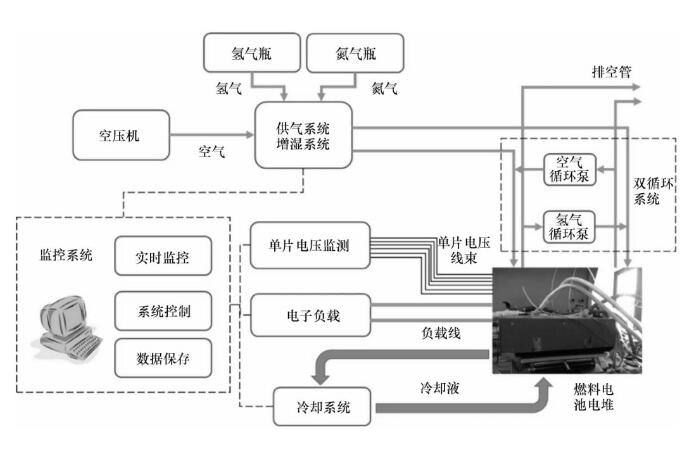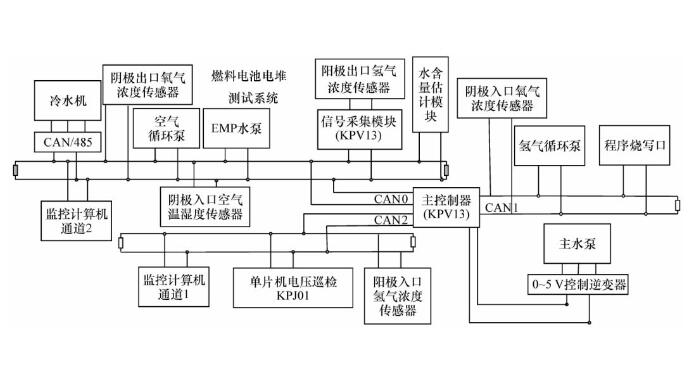Address:Ningbo Free Trade Zone West Zone Overseas Students Pioneer Park
Weburl:http://www.h2-bank.com
E-mail:yangjun@h2-bank.com
Source: Automotive Engineering Research and development of a multifunctional fuel cell stack experimental platform
Preface
In order to develop a long-life and high reliability fuel cell system that is leading in China and surpassing the world's advanced level, it is urgent to have a matching R & D test platform. Therefore, Tsinghua team developed a multi-functional fuel cell stack test platform for in-depth study of vehicle fuel cell stack characteristics and system control. After several rounds of design, improvement and trial use, the platform has been able to effectively test the internal temperature, pressure, humidity, current density and other performance parameters of the fuel cell stack.

Schematic diagram of fuel cell double cycle experiment system
System structure of multifunctional testing platform
The multi-functional fuel cell test platform is mainly composed of fuel cell stack gas supply system, humidification system, cooling system, electrical system and monitoring system, and its system structure is shown in the figure below.

Multifunctional fuel cell stack test platform
- air supply system and humidification system. The high-pressure air required for the fuel cell stack operation is provided by the air compressor in the laboratory, the hydrogen for testing is provided by the high-pressure hydrogen cylinder in the explosion-proof hydrogen room, and the nitrogen for purging is provided by the external nitrogen cylinder. Among them, in order to solve the problem of large pressure fluctuation in the process of air supply during the experiment, which leads to inaccurate air flow control, through the system spectrum analysis of measured pressure fluctuation, the corresponding pressure stabilizing tank and valve are designed to solve the problem of gas supply pressure fluctuation. In order to ensure the safety of hydrogen use, the hydrogen monitoring system is installed in the laboratory, which realizes the safety function of automatic forced ventilation and cut off the hydrogen supply in case of hydrogen leakage. The test platform is equipped with cathode film humidifier and anode bubble humidifier, which can choose whether air and hydrogen intake humidification and flexibly set humidification water temperature to meet the requirements of different experimental research.
- cooling system. In view of the large time constant of fuel cell cooling system, a water temperature control algorithm based on model prediction is designed, which successfully achieves the goal of controlling the fluctuation of cooling system water temperature within ± 1 ℃. This method has been applied to the cooling system control of fuel cell bus. In order to study the cold start problem of fuel cell engine, an industrial water chiller is integrated into the test system, which can provide the fuel cell stack with a coolant temperature of - 25 ℃, and provide experimental conditions for the study of the cold start process of fuel cell at the system level.
- electrical system. In the aspect of electrical system, the flexible design is carried out, that is, the electronic load of the stack can be selected from commercial DC electronic load to meet the normal research and testing needs; the electrochemical workstation can also be selected to measure the AC impedance in the fuel cell stack for the research of fuel cell water management. On this basis, a single-chip voltage inspection device for vehicle fuel cell is integrated, and data fusion is realized through vehicle can bus technology.
- monitoring system. On the one hand, the important research topic of the fuel cell life problem is the research of the internal working mechanism of the fuel cell stack, which needs to obtain a lot of relevant measurement parameters; on the other hand, in order to obtain all the required parameters in real time and accurately, it is also necessary to solve the electromagnetic interference, such as the interference between weak electricity and strong electricity. Based on LabVIEW software platform and can bus network communication technology, the monitoring interface, system control, status monitoring, data collection and data storage are effectively integrated. The real-time communication between sensors, actuators and monitoring software is realized by using vehicle can bus technology. The communication rate is 250kbps / 500kbps. The can network topology is shown in the figure below. By using the network distributed control technology, the problems of electromagnetic interference and sampling delay are avoided, which provides a strong guarantee for the smooth experiment.

Network communication and data fusion system
Telephone
